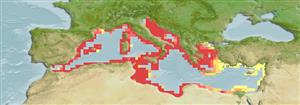Common names from other countries
Environment: milieu / climate zone / depth range / distribution range
Écologie
; profondeur 0 - 150 m (Ref. 435). Tropical, preferred 18°C (Ref. 107945); 46°N - 30°N, 5°W - 36°E
Distribution
Pays | Zones FAO | Écosystèmes | Occurrences | Introductions
Mediterranean: from Spain, north to Slovenia, and east to Turkey. Misidentified in Eastern Atlantic.
Length at first maturity / Taille / Poids / Âge
Maturity: Lm ? range ? - ? cm Max length : 22.0 cm CL mâle / non sexé; (Ref. 435)
Maximum carapace width: 18.0 cm. Maximum depth from Ref. 114133. Occurs from the sublittoral area (Refs. 435, 106904) to depths of about 90 m (Ref. 106904), on rocky bottoms with algae (Ref. 435). Juveniles are predominantly found in shallow waters with mixed hard-and-soft bottoms. Adults live in deeper areas (Ref. 106904).
Life cycle and mating behavior
Maturité | Reproduction | Frai | Œufs | Fécondité | Larves
Members of the order Decapoda are mostly gonochoric. Mating behavior: Precopulatory courtship ritual is common (through olfactory and tactile cues); usually indirect sperm transfer.
Fischer, W., G. Bianchi and W.B. Scott (eds.). 1981. (Ref. 435)
Statut dans la liste rouge de l'IUCN (Ref. 130435)
statut CITES (Ref. 108899)
Not Evaluated
Not Evaluated
Utilisations par l'homme
Pêcheries: commercial
FAO - Aquaculture: production; pêcheries: landings | FishSource | Sea Around Us
Outils
Plus d'informations
Taille/Âge
Croissance
Longueur-poids
Longueur-longueur
Morphologie
Larves
Abondance
Sources Internet
Estimates based on models
Preferred temperature
(Ref.
115969): 8.2 - 20.1, mean 11.1 (based on 752 cells).
Vulnérabilité
Low vulnerability (12 of 100).
